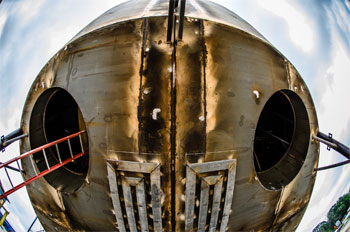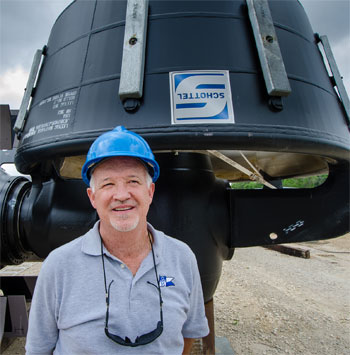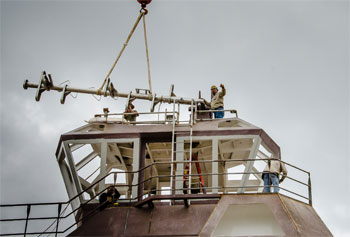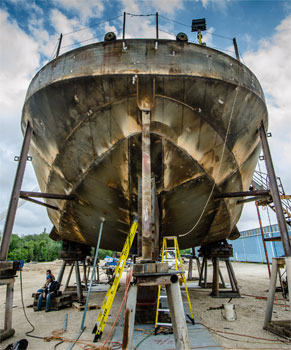G&H Towing of Galveston, Texas, the operating company for Bay-Houston Towing and Suderman & Young Towing, has two more Robert Allan Ltd. Z-Tech tugboats, one for each company, under construction at LeeVac Shipyards, Jennings, La.
The first of the 80-foot, 5,150-hp ASD tugs, Chloe K, is scheduled for delivery to Bay-Houston in the third quarter of 2013. The second boat, Zeus, will go to Suderman & Young in the fourth quarter of 2013. When delivered, the G&H fleet of 31 tugs will have eight of the Vancouver-based naval architect’s Z-Tech tugs.
 |
|
The z-drive holes in the stern of Zeus, which is expected to have a bollard pull of 60 metric tons. |
Bay-Houston and Suderman & Young each have a Z-Tech 7500 series tug, Hercules and Tristan K, in Cameron, La., deployed in a joint venture with Moran Towing, servicing the Sempra LNG terminal.
“We scaled down the basic design of the 7500 version of our other Z-Techs,” said Mike Nigro, vice president of engineering for G&H. “Working with Robert Allan’s team, we took ideas from several Z-Tech classes and arrived at the 2400 class. These are the first ones of this class from Robert Allan.”
Typically the numbering, or class, of the various Z-Tech designs is based on metric bollard pull, 75 tons in the case of the six 7500 series already in the G&H fleet. “On this boat it relates to the length,” said Nigro.
“We were looking for a compact boat with a little less draft to work at the upper end of the Houston Ship Channel,” said Nigro. “The deepest draft is 16.2 feet as opposed to 19.6 feet on the bigger boats. We wanted to keep from having to move the bigger boats up from Barbours Cut.”
 |
Chloe K and Zeus are a bit stubbier in profile than their predecessors, primarily due to a shortened bow. The 2400 class is 18 feet shorter than the 98.3-foot 7500s, but with a beam of 38.3 feet, only a foot less in girth. As with the bow, the pilothouse is a little shorter. “The skeg size and shape was kept proportional to the reduced dimensions of the tug,” said Nigro.
An innovation taken from the two 7500s based with Moran at Cameron LNG is the addition of dry-docking skegs, or z-drive guards, located aft of the large skeg and foreword of the z-drives. They, in conjunction with the large skeg, form a tripod supporting the tug in dry dock, saving labor and cost. A second benefit is that the guards protect the z-drives from damage when the boat is grounded.
 |
|
Mike Nigro, VP of engineering for G&H Towing, with a z-drive destined for Zeus. |
The propulsion for each boat is a pair of Caterpillar 3516 C Tier 3 mains at 2,575 hp each with Schottel SRP 1215 z-drives turning 94.5-inch diameter propellers in nozzles. The bollard pull is expected to be 60 metric tons and the speed is expected to be 11 to 12 knots.
The configuration of equipment on the bow generated an interesting discussion between Nigro and Blaine Dempke, president of Markey Machinery, the Seattle-based company that supplied the hawser winch.
Helping somewhat in the bow arrangement, and applicable because of the reduced bollard pull, was that a smaller bow winch would suffice. Markey had also placed the hawser winches on the 7500s, so there was familiarity in the mix. But things were still a bit tight.
“One of the challenges was keeping the level wind and staple location and spacing correct to prevent wear on the level wind,” said Nigro. “And to accomplish everything we needed to do in order to cut 18 feet off the basic boat, we had to move the winch back and that required moving the stairwell to the lower quarters.
“Mike Nigro came to us saying they were going to build two ‘shortened’ Z-Techs and could we come up with a brand new winch design that took up less space on the reduced size foredeck,” said Dempke. “We set forth and came up with a new Markey design, the DEPCF-48S, which places the electric motor under the level wind, thereby shortening the winch substantially and increasing the distance in front of the winch between the level wind and the staple. Maximizing this distance is critical in order to reduce the load on the level wind, and to provide a work area for the crew.”
Dempke went on to say that this type of custom solution is not that unusual for Markey because of its years of experience designing winches for a plethora of hull shapes and sizes. The new winch also boasts Markey’s Render/Recover function and Line Tension Display System.
ASD tugs must be maneuvered under the extreme flare on a modern ship’s bow, a tight spot, often in a tight harbor, a place where damage can occur.
“We upgraded the fendering on the bow to get access under the flare of the ships,” said Nigro. “We put these boats in places where conventional tugs don’t go, and we want to make sure that we don’t damage the ship or the tug.”
Schuyler Rubber’s Broussard, La., office supplied 52 feet of 36-inch cylindrical fender to wrap the curve of the bow bulwark. It is chained and strapped with attachments through the bulwark. Below the bow fender, a section of extruded D rubber is installed to protect the lower section of the bow and the forward end of the skeg. A cylindrical fender also protects the stern. The lower bow and side shell are covered with SR3D double loop fendering. The bitt fenders were designed to allow for easy removal for maintenance and repairs.
 |
|
Lifting the mast into position above the pilothouse of Chloe K, the first of the 80-foot, 5,150-hp Z-Tech tugs. The boat is due for delivery to Bay-Houston Towing this summer. |
“The bitt fenders are located just under the bitts, which are typically used to tie the boat up,” said Dale Langley from Schuyler’s Broussard office. “The reason they have been designed this way is that they are most likely to be damaged before any other fenders. This design allows for ease of removal and installation without gas freeing the tug, which saves the end user substantial expense.”
“We also sloped the bulwarks back and lowered it four inches to get better access under the flare of the ships,” said Nigro. In essence, the Z-Tech tug was designed to operate with modern ships and to combine the handling and operational characteristics of both z-drive tractor tugs and ASD tugs, especially for operations in major ports and marine terminals.
The design, with its set-back pilothouse and flat forward sheer, allows for more working area around the winch and is particularly suited to working under the extreme flare of ships. The pilothouse is also inset toward the centerline, allowing the tug to huddle closer under the flare to assist the ship beam on.
“The exhaust stacks have been moved inboard and aft of the wheelhouse in comparison to the 7500 class,” said Nigro. “This prevents having a blind spot on each side of the wheelhouse. Also since the stacks are moved aft, this will prevent the stacks from being damaged.”
A Z-Tech has one hawser winch, which becomes the towing winch when the tug transits stern first in tractor-tug mode, pulling with the hawser winch on the bow. To ensure good sea-keeping capability while transiting stern first, the tug has a “seagoing” stern, which has a strong vertical sheer and is well rounded. As with all ASD tugs, the Z-Tech has omni-directional speed and the bollard pull is comparable pulling forward or astern.
In order to have continuity of controls and a familiar feel for the interchangeable crews within the Z-Tech fleet, the layout of the Furuno electronics and Icom radios, the joysticks and winch controls in the pilothouse mimics the larger tugs, but in a smaller space. However, Nigro said that the dimensions of the crew staterooms are the same as the bigger boats.
It had been some time since there was a tug under construction at LeeVac. The last one out of the yard in 1996 was the 4,300-hp ASD Kinsman Venture (ATR 1997). A couple of lives later, re-powered to Tier 2 and renamed Millennium Maverick, the tug is currently working for the Harley Marine Services subsidiary Millennium Maritime in the ports of Los Angeles and Long Beach.
In the meantime, LeeVac Shipyards has constructed a strong string of PSVs and oil industry support vessels. The introduction of a complex hull shape, a departure from a more boxy OSV, threw a few curves into the yard’s typical launching process.
“One of the immediate considerations was to determine how to transfer the hull from the fabrication bay to the water,” said Joe Bailey, LeeVac’s senior project manager. “Due to the shape of the hull and the locations of the docking skegs and escort skegs, a conventional side launch was not practical. The solution to the hull transfer is to utilize SPMTs (self-propelled modular transporters) to transfer the hull from land to our dry dock.”
LeeVac Shipyards sits in the shadow of the Highway 90 bridge that spans the Mermentau River, a tan-colored snake of water coursing its way to the Gulf of Mexico via Lake Arthur and the Gulf Intracoastal Waterway. The route presents draft issues for a heavy-hulled tug. Once launched, Chloe K, and later Zeus, will be towed to the LeeVac yard in Lake Charles, La., established two years ago and connected to the Gulf by a deep-draft shipping channel. The tugs will be finished up at the new facility for delivery to Bay-Houston Towing and Suderman & Young Towing from there.

